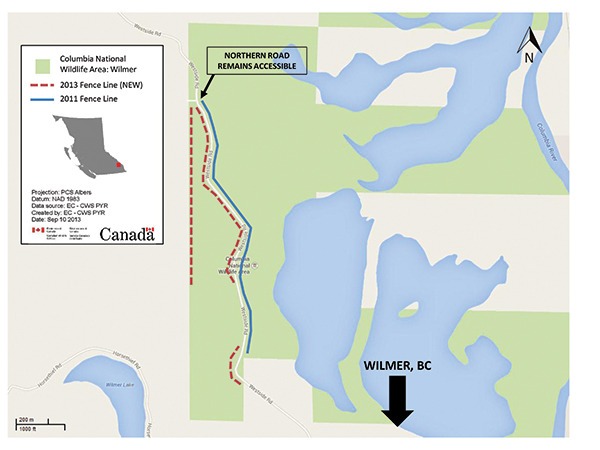Environment Canada’s Canadian Wildlife Service has made a little-known federally protected unit of land that lies ten minutes north of Invermere a national priority.
This year, the federal agency approved a capital project for what’s known as the Columbia National Wildlife Area (NWA), which protects some of Canada’s most valuable habitat for migrating waterfowl, fish, plants and species at risk.
To improve this protection, new fencing, signage and boulders were introduced across the Wilmer unit of the Columbia NWA in late summer and early fall. Although parts of the NWA are already fenced with signage, the capital project allowed for approximately 2.5 kilometres of additional fencing to be erected alongside Westside Road.
Several unlicensed access roads were decommissioned with large one-tonne boulders and trenches installed to discourage continued access by off-road vehicles, and more fencing may be erected in the future, said Environment Canada spokesperson David Sullivan.
“The Columbia NWA contains sensitive habitat for wildlife,” he said. “The area has been negatively affected by prohibited activities such as the use of unauthorized vehicles.”
“Decommissioning the roads is necessary to ensure vehicles are not able to access the site and involves placing boulders and installing fencing to prohibit entry,” added Mr. Sullivan. “The Canada Wildlife Act specifies that individual offenders can be held liable for damages, and may be punishable by vehicle forfeiture, fines and imprisonment.”
Over one thousand hectares in size, the Columbia National Wildlife Area is one of 54 such areas across Canada, which are created and managed for the purposes of wildlife conservation, research and interpretation. Wildlife areas across Canada protect about a million hectares of nationally significant land and marine habitat for animals and plants.
Currently, the Canadian Wildlife Service manages four units in the Columbia NWA: Wilmer, Spillimacheen, Brisco, and Harrogate. Approximately 529 hectares make up the Spillimacheen, Brisco and Harrogate units, which are owned by the Nature Trust of British Columbia and leased to the Canadian Wildlife Services to form the Columbia NWA together with the 787-hectare Wilmer property acquired by the Canadian Wildlife Service in 1978.
There are just four other NWAs in British Columbia: the Alaksen National Wildlife Area (NWA), which is part of the Fraser River delta; the Qualicum National Wildlife Area on the east coast of Vancouver Island; the Vaseux-Bighorn National Wildlife Area (NWA) located in the south Okanagan–Similkameen region; and the Widgeon Valley National Wildlife Area (NWA) near Pitt Lake, 65 kilometres east of Vancouver.
Activities and access to the Columbia NWA are regulated through the Wildlife Area Regulations under the authority of the Canada Wildlife Act, and access by motorized vehicle, horse or bicycle is prohibited.
However, some seasonal activities such as hiking, canoeing, and wildlife viewing are permitted provided that they do not result in negative impacts to the conservation values of the area. Dogs are also welcome, but must be leashed and under control at all times.
The current “trails” were established by public foot traffic, said Mr. Sullivan, referring primarily to the trail from Westside Road to Policeman’s Point, a spur of land which overlooks the wetlands.
“This trail will remain; however, it is currently not maintained and is used at the public’s risk,” he said.
Access to the Columbia NWA is by foot only and is best done via the unmaintained trail from Westside Road to Policeman’s Point, with parking just off Westside Road. Mr. Sullivan said future signage will include a map of the area and information on prohibitions, while work with respect to conservation and restoration in the area is ongoing.
